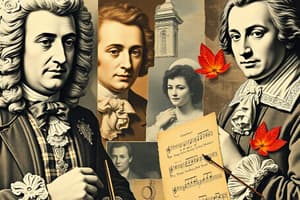Podcast
Questions and Answers
The Baroque period was characterized by a focus on simplicity and minimalism.
The Baroque period was characterized by a focus on simplicity and minimalism.
False (B)
George Frideric Handel was a renowned organist and composer.
George Frideric Handel was a renowned organist and composer.
False (B)
The harpsichord was a popular instrument during the Renaissance period.
The harpsichord was a popular instrument during the Renaissance period.
False (B)
A concerto typically features a soloist or group with piano accompaniment.
A concerto typically features a soloist or group with piano accompaniment.
Claudio Monteverdi was a composer who primarily wrote music for the Renaissance period.
Claudio Monteverdi was a composer who primarily wrote music for the Renaissance period.
The suite is a type of vocal composition that tells a biblical story.
The suite is a type of vocal composition that tells a biblical story.
Antonio Vivaldi was a renowned composer of operas.
Antonio Vivaldi was a renowned composer of operas.
The recorder is a type of brass instrument.
The recorder is a type of brass instrument.
J.S. Bach's Air on the G String is a famous solo violin work.
J.S. Bach's Air on the G String is a famous solo violin work.
What is the region of Portugal where Sevilhanas originated from?
What is the region of Portugal where Sevilhanas originated from?
What is the typical group composition of Sevilhanas dancers?
What is the typical group composition of Sevilhanas dancers?
What is the characteristic of Sevilhanas dance movements?
What is the characteristic of Sevilhanas dance movements?
What type of instruments are typically used in Sevilhanas music?
What type of instruments are typically used in Sevilhanas music?
What is the cultural significance of Sevilhanas in Portugal?
What is the cultural significance of Sevilhanas in Portugal?
What is often used to add flair and drama to Sevilhanas performances?
What is often used to add flair and drama to Sevilhanas performances?
What is a characteristic of modern Sevilhanas variations?
What is a characteristic of modern Sevilhanas variations?
What is the historical influence on Sevilhanas dance?
What is the historical influence on Sevilhanas dance?
Flashcards are hidden until you start studying
Study Notes
Baroque Music (1600-1750)
Characteristics:
- Complex harmony and counterpoint
- Ornate and intricate ornamentation
- Use of basso continuo (continuous bass line)
- Emphasis on emotional expression and drama
- Often featured virtuosic performances
Composers:
- Bach, J.S.: Organist and composer, known for his fugues and inventions
- Handel, G.F.: Composer of operas, oratorios, and instrumental music
- Vivaldi, A.: Violinist and composer, famous for his concertos
- Monteverdi, C.: Composer who bridged the Renaissance and Baroque styles
- Telemann, G.P.: Prolific composer of instrumental and vocal music
Instrumentation:
- Harpsichord: A popular keyboard instrument, often used in continuo
- Violin: Featured in solo and ensemble music, including concertos
- Cello: Used in solo and ensemble music, including suites
- Recorder: A popular woodwind instrument, often used in consorts
Forms:
- Concerto: A work featuring a soloist or group with orchestral accompaniment
- Suite: A collection of dances, often in a specific order
- Fugue: A contrapuntal composition featuring interwoven themes
- Oratorio: A large-scale vocal work, often telling a biblical story
Key Works:
- Bach, J.S. - Air on the G String: A beautiful and famous orchestral suite movement
- Handel, G.F. - Messiah: A famous oratorio, featuring the "Hallelujah" chorus
- Vivaldi, A. - The Four Seasons: A set of violin concertos, evoking the seasons
Baroque Music Characteristics
- Characterized by complex harmony and counterpoint, ornate and intricate ornamentation, and emphasis on emotional expression and drama.
- Featured virtuosic performances and use of basso continuo, a continuous bass line.
Notable Composers
- Bach, J.S.: Renowned organist and composer, known for his fugues and inventions.
- Handel, G.F.: Composer of operas, oratorios, and instrumental music, famous for his oratorio "Messiah".
- Vivaldi, A.: Violinist and composer, famous for his concertos, including "The Four Seasons".
- Monteverdi, C.: Composer who bridged the Renaissance and Baroque styles.
- Telemann, G.P.: Prolific composer of instrumental and vocal music.
Instrumentation
- Harpsichord: A popular keyboard instrument, often used in continuo.
- Violin: Featured in solo and ensemble music, including concertos, such as Vivaldi's "The Four Seasons".
- Cello: Used in solo and ensemble music, including suites, such as Bach's "Air on the G String".
- Recorder: A popular woodwind instrument, often used in consorts.
Musical Forms
- Concerto: A work featuring a soloist or group with orchestral accompaniment, such as Vivaldi's "The Four Seasons".
- Suite: A collection of dances, often in a specific order, such as Bach's "Air on the G String".
- Fugue: A contrapuntal composition featuring interwoven themes, characteristic of Bach's compositions.
- Oratorio: A large-scale vocal work, often telling a biblical story, such as Handel's "Messiah".
Sevilhanas as a Folk Dance
Origins and History
- Traditional folk dance from Portugal, specifically from the Porto region.
- Roots in the Middle Ages, influenced by Moorish and Arabic cultures.
Characteristics
- Performed in groups of couples, each consisting of a man and a woman.
- Intricate footwork, hand clapping, and dramatic body movements.
- Fast-paced rhythm and energetic movements.
Music
- Accompanied by traditional Portuguese music.
- Features instruments such as guitar, accordion, and drum.
- Lively and upbeat tempo.
Costumes and Props
- Traditional Portuguese costumes worn, including long skirts and ornate shawls for women.
- Ornate vests and trousers for men.
- Props like handkerchiefs, fans, and castanets used for added flair.
Cultural Significance
- Important part of Portuguese cultural heritage.
- Performed at festivals, weddings, and other celebrations.
- Symbol of Portuguese identity, promoting cultural exchange and understanding.
Variations and Evolution
- Evolved and adapted to different regional styles and influences over time.
- Modern variations incorporate new music styles and choreography.
- Maintains traditional essence of the dance.
Studying That Suits You
Use AI to generate personalized quizzes and flashcards to suit your learning preferences.




